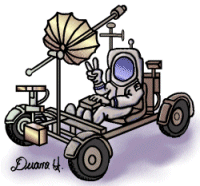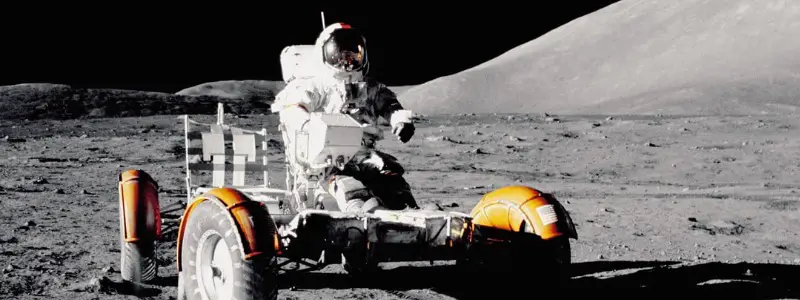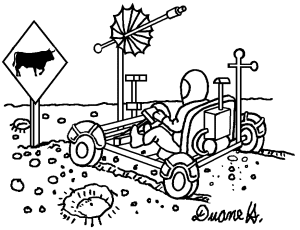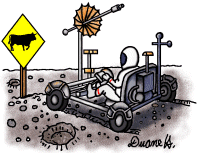Facts about the Lunar Rover
Table of Contents
Quick! What’s 30 years old, weighs 80 pounds (on the Moon), gets great gas mileage, and folds up like a Transformer toy?
 The answer is NASA’s Moon Buggy, the original interplanetary Sport-Utility Vehicle.
The answer is NASA’s Moon Buggy, the original interplanetary Sport-Utility Vehicle.
During the Apollo era of lunar exploration in the late 1960’s astronauts discovered that hiking around the Moon was more tiring and disorienting than they expected. Scientists on Earth wanted them to retrieve hundreds of pounds of moon rocks from geological sites that were very far from the Lunar Module. That’s a lot to expect after a 384,400 km journey from Earth!
Fortunately, NASA engineers had a solution. They designed a lightweight, space-age dune buggy that could fold up inside the tight confines of the Lunar Module. Deployed on the dusty lunar surface, the “Moon Buggy” was able to travel 50 km across the Moon’s cratered terrain and carry more than its own weight in moon rocks and passengers. The amazing Moon Buggy allowed astronauts to explore farther and better than ever.

Three of NASA’s lunar rovers are still on the Moon, waiting patiently for the day that humans return for another wild ride.
Four Facts about the Moon Buggy
- The first lunar rover (a.k.a. “Moon Buggy”) landed on the Moon aboard the Apollo 15 lunar module on July 30, 1971.
- The Moon Buggy was about the size of a Lincoln Continental, but had to fold up smaller than a Volkswagen to fit inside the Apollo spacecraft.
- The wheels on the Moon Buggy were made of woven piano wires. Each wheel was independently powered by its own electric motor.
- Today, three abandoned lunar rovers still sit on the Moon near the landing sites of Apollo 15, 16 and 17.
The Amazing Moon Buggy
You have just been invited on a space trip! You travel for days through dark space dotted with sparkling stars. As you look out the port window, you see the beautiful blue and white planet Earth glowing in reflected sunlight. Looking in the other direction, you see a shining pearl in the sky – the Earth’s moon. You smile and your stomach leaps with excitement as you think about exploring the Moon for the first time. Looking at maps and photographs of the Moon’s surface, you eagerly say the strange names of the places near your landing site: Apennine Mountains, Autolychus, Archimedas, and Aristillus.
 After a smooth landing, you decide right away that the Moon is the most wonderful place that you have ever seen! You hurry to put on your space suit so that you can go out and walk across the bizarre landscape. No pictures prepared you for the overwhelming sense of excitement that you feel as you gaze at the Moon’s weird surface. Once you touch the ground, you jump for joy, and wow – what a jump! The low gravity makes it easy to pop 6 feet high into the sky. Because you only weigh about 17% of your Earth weight, your muscles are powerful. Running seems clumsy because your push-off foot propels you high into the air for a long stride; you do not feel quick but you can cover a lot of ground.
After a smooth landing, you decide right away that the Moon is the most wonderful place that you have ever seen! You hurry to put on your space suit so that you can go out and walk across the bizarre landscape. No pictures prepared you for the overwhelming sense of excitement that you feel as you gaze at the Moon’s weird surface. Once you touch the ground, you jump for joy, and wow – what a jump! The low gravity makes it easy to pop 6 feet high into the sky. Because you only weigh about 17% of your Earth weight, your muscles are powerful. Running seems clumsy because your push-off foot propels you high into the air for a long stride; you do not feel quick but you can cover a lot of ground.
Just as you are ready to start off on the adventure of a lifetime, your radio crackles, “Good morning astronauts, this is Houston. Just a reminder from mission control…you need to stay within 1000 feet of your lander.”
“What?”
“That’s right, we’re afraid you might get tired or lost.”
Does this sound hard to believe?
Believe it. It really happened. The early astronauts on the Apollo missions to the Moon were not allowed to go far from their space ship. Even though the astronauts wanted to explore, they were disappointed. After the first moon landing, Apollo 11’s Neil Armstrong argued that a loping gait could carry astronauts and supplies for many miles with little effort. Why did Mission Control say no? During astronaut training in the low gravity simulator, they discovered that astronauts became surprisingly tired. Working in low-gravity wasn’t as easy as it sounded!
What about getting lost?
Well, when you are in a strange place it can be hard to remember where you came from. The Apollo astronauts always landed in wide flat areas on the Moon. Everything around the landing site was a shade of gray, so finding something — like a specific crater — could be tricky. The Apollo 14 astronauts Alan Shepard and Edgar Mitchell had to give up on a rock collecting trip to the Cone Crater when they became confused by the landscape. Later they realized that they were only 30 meters (about the length of three classrooms) away from the rim of the crater when they gave up the search.
The astronauts really wanted to explore the Moon and scientists wanted more samples of moon rocks. They needed a way of traveling around that didn’t make the astronauts tired or lost. This was a tricky problem. The astronauts needed a vehicle that they could carry to the Moon inside the small lunar lander. But it would also have to be big enough to convey astronauts, equipment, and lots of Moon rocks. This was a job for the ultimate off-road vehicle — something that could move around on the surface of the Moon where there are no paved roads, lots of rocks, and a deep layer of fine sand. It would have to work where there was little gravity, no air, and where the temperature changes four hundred degrees between night and day. It would also have to be safe and reliable, since there are no tow trucks or repair stations on the Moon.
What did they do?
Engineers invented a new kind of dune buggy! Called the Lunar Rover Vehicle (LRV), the new “Moon Buggy” made it possible for astronauts of the Apollo 15, 16 and 17 missions to explore more of the Moon than ever before. To keep the Moon Buggy as light as possible, it was built mostly of aluminum. Each wheel was powered by a quarter-horsepower electric motor. It was 10 feet long (3 m), 6 feet wide (1.8 m), and had a ground clearance of 14 inches (35.6 cm). The wheels, which had to be tough, were made of woven piano wires! This moon jeep weighed 462 pounds (210 kilograms) on Earth and 77 pounds (35 kg) on the Moon. This was not a speedy jeep: its top speed was about 7 miles per hour (11 km/h).
How did this jeep fit into the lunar lander?
The designers made the Moon Buggy fold up like a lawn chair. When it was folded, it just barely fit into the lunar lander. On its first trip to the Moon, there were a few scary moments. The rover was supposed to slide easily out of the lunar lander, but the astronauts couldn’t get the rover out! A little part that was supposed to release the rover did not work. Mission Control asked the engineers at the Marshall Space Flight Center to help, but it was a difficult problem to solve. In the end, astronauts David Scott, James Irwin, and Alfred Worden had to use their muscles to lift and push the rover onto the Moon’s surface.
Did the moon rover work?
It worked great! For the Apollo 15 mission, the astronauts drove it 17 miles (27 km) and collected 169 pounds (77 kg) of moon dust and rock! For the Apollo 16 mission, John Young, Thomas Mattingly, and Charles Duke explored the Descartes Highlands and gathered 213 pounds (97 kilograms) of samples from the Moon. During the Apollo 17 mission, Eugene Cernan, Ron Evans, and Harrison Schmitt drove the Moon Buggy over 62 miles (about 100 kilometers) and collected 243 pounds (110kg) of moon stuff. The Apollo 17 mission was the last mission to send humans to the Moon and to use the Lunar Rover to explore the surface.
The spirit of creative design to overcome obstacles is an important part of space science. This spirit is encouraged and celebrated each year at the Marshall Space Flight Center in Huntsville, Alabama during the Great Moon Buggy Race. Each year, students design homemade moon rovers and race them over terrain that has some of the same features as the Moon’s surface. Some of the ideas used to design these racing rovers may one day help engineers to design even better rovers for exploring the Moon and other planets.
The real Moon rover was an amazing success. Although it was a simple design that did not fly or jump, it allowed astronauts to travel far and wide over the most hostile terrain ever encountered by a 4×4. The amazing rovers that Apollo astronauts carried to the Moon are still up there, thirty years later. They left them behind to make room for moon rocks in the returning lunar module. The next time the Moon is full, go outside and take a look. You can’t see the three Apollo rovers, but they are there waiting for humans to return one day for another exciting ride.
Teacher Lesson Plan: Lunar Rover Lunacy Game
Objective: The students will write questions based on the Moon Buggy article and use them to play a game.
 Materials: The students will need scissors, coloring pencils, the article (for younger kids; for older kids), 30 halved 3×5 index cards, one penny (or other coin) per playing group, the game directions, Lunar Rover game markers, and the game board. You can also distribute this fact sheet as a source of questions for the game.
Materials: The students will need scissors, coloring pencils, the article (for younger kids; for older kids), 30 halved 3×5 index cards, one penny (or other coin) per playing group, the game directions, Lunar Rover game markers, and the game board. You can also distribute this fact sheet as a source of questions for the game.
Estimated Time: If your students are quick, they might finish in a 45 minute period. Fourth and fifth graders probably need two periods. Younger students would need 3 periods.
Procedure:
- Distribute the game directions. Read them over with the students. Have students tell you what materials they need.
- Hand out the game boards and Lunar Rover game markers. The students will color these using colored pencils.
- Distribute the index cards. The cards need to be cut in half. Ask students what the cards are for. Discuss the characteristics of good questions. Have students generate some examples. Also discuss bad questions, for example, “What is the fourth word in the 15th line of the story?” Writing the questions is the most difficult yet most important part of the lesson. It may help to have students work in pairs or trios.
- As students finish questions, peruse them for acceptability. When they have written 30 acceptable questions (For younger students you might make it 10), give them the rover markers and the game board to decorate.
- When most groups are finished, reread and discuss the game rules and the symbols. You may do this as a class or have students to it themselves.
- Give students time to play the game. When it seems like a good time to stop, discuss the game. What parts of the game did they like? Didn’t like? What would they do to improve it?
Rationale: Building a game is a highly motivating means of reviewing information. Writing the questions is an excellent means of enhancing comprehension as well as developing questioning skills. This game links different forms of intelligence to the information.
Teacher Lesson Plans: Moon Buggy Cause and Effect
Objective: The student will identify and write causes and effects from the Lunar Rover article.
Materials: The student will need a copy of the activity sheet and the article.
Estimated Time: This activity will take about 15 minutes.
Procedure:
- After the students have read the article, distribute the activity sheet. Read the directions together. Before starting the chart, have students give examples of causes and effects in their own lives. For example, hunger would be an effect, not eating breakfast would be a cause.
- Read the first event on the chart. Have students locate the event in the article. Ask students to identify the cause of that event and then and effect of that event. Depending on the ability level of your students, you may wish to continue working with them or let them work independently.
- After completing the chart, have students discuss how they figured out their answers. This is not as easy as it sounds.
Rationale: Cause and effect is a common organizational tool used by non-fiction writers. Clarifying and understanding this relationship will improve comprehension skills. In this case, it also provides students an opportunity to review and organize information from the article, improving comprehension and retention.
